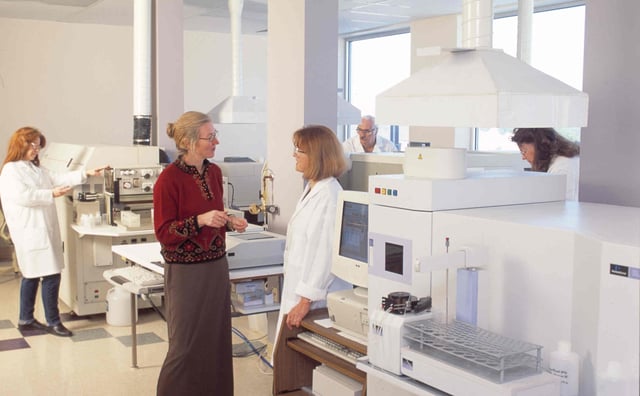Generating high quality, accurate laboratory results starts with high quality, accurate standards. If your calibration standards are not correct, the analyses will not be accurate. Here are three common mistakes, and what you can do to avoid them, when preparing aqueous calibration standards for use in AA, ICP, or ICP-MS techniques.

Maintaining the matrix of the standard when diluting to prepare working standards
When preparing dilutions of aqueous, multi-element standards to be used as calibrants for your instrument, it is important to maintain the acid matrix of the neat standard, both in terms of components and final concentrations.
In other words, if your neat standard is 5% HNO3/1%HCl, then all of the working standards should be exactly 5%HNO3/1%HCl. Otherwise, element compatibility and solubility can be adversely affected and result in possible precipitation of one or more elements in the working standard.
An example of this would be a multi-element mix containing 100 ug/g of Fe, Ni, Sb, Zn, Cu, Ba, and Cd in a 5%HNO3/1%HCl matrix. Most of the elements – Fe, Ni, Zn, and Cd – are stable in 5%HNO3. However Sb requires a small amount of HCl to maintain its solubility (when made directly from the metal and not an Sb salt). If the HCl is left out, the bn will start to precipitate out in the working standard, and will result in analyses that are biased high for Sb. (NOTE: If your actual standard concentration is lower than the theoretical concentration value because of precipitation, your analytical results will be biased high – the opposite of what you might initially think. Remember that you are equating a lower intensity signal with a higher theoretical value. In actuality the true concentration is lower due to precipitation. In order to correct, you need to multiply your results by Actual Standard Concentration Value/Theoretical Standard Concentration Value, which will always be <1 if your standard has elements that have precipitated. This approach is not recommended as a correction technique; standards should always be prepared again with the proper matrix acids and concentrations.
Alternately, multi-element standards can be purchased in the final working concentrations so that no dilutions prior to use are necessary. Although this approach may be initially more expensive, it guarantees that the working standards are correct and can save the expense of sample reruns by the laboratory.
.jpg?width=320&name=test%20tubes%20(2).jpg)
Ensuring calibration standards are compatible with your sample introduction system
Having problems with a drifting or inconsistent Si signal? The most likely cause is that the calibration standard contains free fluoride and is being used with a sample introduction system that has at least one glass component – the nebulizer, the spray chamber, and/or the torch. This can occur when the standard contains elements that typically require hydrofluoric acid for preparation or stability, such as W, Ti, Hf and Si. Normally the standard would list HF or trace F- as part of the matrix. However if it is below 0.2%, it may not be listed as part of the matrix, particularly if no additional acid was added during the preparation of the neat standard. Even small or trace amounts of free F- will quickly leach Si (and possibly B or Na, depending on the type of glass utilized in the sample introduction system) from those glass components, and make it impossible to achieve a stable baseline signal.The straightforward solution is to switch to an HF-resistant sample introduction system. These systems typically use an alumina or sapphire torch insert and inert fluoroplastic materials such as PFA for the nebulizer and spray chamber. This type of system is required if your samples are prepared using HF and you are not completely complexing the free F with an alkali borate addition. Most stainless steel alloys, titanium alloys and other refractory mixes require a multi-acid digestion including HF for complete dissolution of the sample. New short wave infra-red digestion systems can however significantly reduce the total volume of acids required (including HF) for the digestion and substantially shorten dissolution times.
If you do not have the option of an HF-resistant sample introduction system (nebulizer, spray chamber and inner torch all must be HF-resistant), request your standards provider to make a neat standard that does not contain any free fluoride. In most cases, this can be done with alternate starting materials for the elements of interest.
Standards undergo sample preparation procedures to match the samples being analyzed
Are you taking your working standards through a digestion or extraction step to duplicate how your samples are being processed? This can lead to problems similar to the first example above, where the ending matrix of your samples and standards is different than the matrix of the neat standard.
As an example, let’s take a standard with 100ug/g Cu, Cd, Ba, Pb, Tl, and Ag in 5%HNO3. Your sample preparation procedure involves a nitric/hydrochloric extraction of the standard and the samples. The well-known precipitation of insoluble AgCl will occur when you extract the aqueous standard, and often can be visually seen as a white, cloudy solution. However, there are other elements less well known that can suffer reduced solubility in the presence of HCl as well, including Pb and Tl.
The best approach to prevent this error from occurring is to request that the neat standard be made in the same matrix as your final samples, in this case a nitric/hydrochloric acid mix. During preparation of the neat standard, Ag, Pb and Tl can be pre-complexed with concentrated HCl, and will be stable in the final mixed acid matrix. Again, discuss your requirements with your standards provider so that a standard can be designed to best meet your individual needs.
One final recommendation that is helpful when you are preparing a set of working standards from the neat standard – initially prepare a large volume of the appropriate acid pre-mix (5%HNO3, 5%HCl/1%HNO3, etc.) that can be used to dilute all working standards. This helps ensure that all standards have exactly the same matrix (including any impurities present) and will help eliminate variations in nebulization efficiency due to differing acid concentrations. Use of an internal standard can also help eliminate these effects – more on internal standards to come in future posts!
Have other analytical questions or concerns? Give us a call. We are happy to help. We are not only a standards manufacturer, we are also a commercial analytical laboratory, and hence a user of standards. Let our expertise help solve your lab’s difficult analytical challenges!


